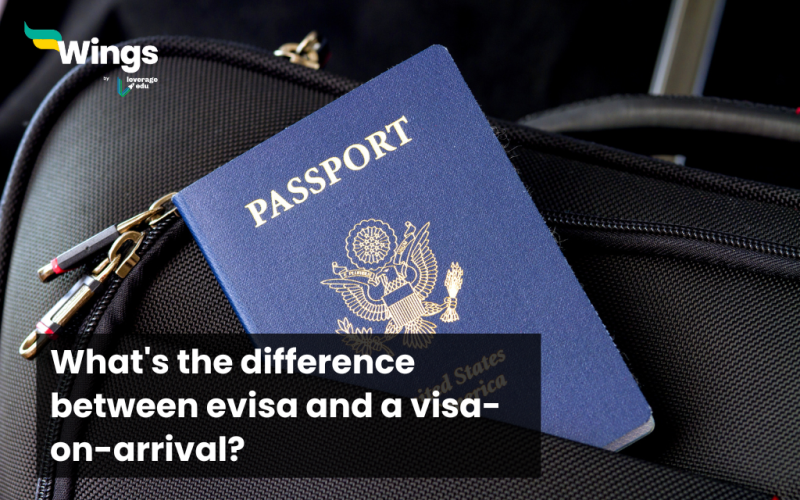Applying for visas is a headache students don’t need. The real problem? Most guides are full of fluff. What is the Difference Between a Regular Visa, E-visa and a Visa on Arrival? is the question every Indian student faces when planning travel, study, or internships abroad. Regular visas take weeks, e-visas click through in minutes, and visas on arrival can either save your trip or ruin it at the airport. This blog breaks down every type, shows pros, cons, costs, and timelines, and makes your choice crystal clear for 2026.
This Blog Includes:
- What is the Difference Between a Regular Visa, E-visa & a Visa on Arrival?
- What is a Regular Visa?
- What is an E-visa?
- What is a Visa on Arrival?
- Regular Visa vs E-visa vs Visa on Arrival: Key Differences
- Which Visa Should You Choose: Travel or Study?
- Country-wise Availability: Where Each Visa Works?
- Can You Switch Between Visa Types After Arrival?
- How to Apply for Each Visa Type: Step-by-Step?
- Which One Is the Right Visa for Your Trip?
- FAQs
What is the Difference Between a Regular Visa, E-visa & a Visa on Arrival?
The difference between a Regular Visa, E-visa, and Visa on Arrival comes down to where you apply, how much control you have before travel, processing time, cost, and risk level. Here is a full snapshot of all three visa types in one place, so you instantly know which one fits your travel or study plan without confusion.
| Basis of Comparison | Regular Visa | E-visa | Visa on Arrival |
| Where you apply | Embassy, consulate, or visa centre before travel | Online through official government portal | At the airport or border after arrival |
| Approval before travel | Yes, stamped or sticker visa | Yes, digital approval received by email | No prior approval |
| Processing time | Slow to moderate, usually weeks | Fast, usually days | Immediate but uncertain |
| Documents required | High, detailed paperwork | Moderate, uploaded online | Limited but checked on arrival |
| Interview or biometrics | Often required | Not required | Not required |
| Cost level | Usually higher | Moderate | Often higher at entry point |
| Risk of refusal | Low if documents are correct | Low to moderate | High compared to others |
| Best for | Study, work, long stays | Short trips, tourism, quick plans | Emergency or last-minute travel |
| Control and certainty | Very high | High | Low |
| Validity and stay period | Long and flexible | Short to medium | Usually very short |
What is a Regular Visa?
A regular visa is an official travel permission that students must obtain before travelling to another country. It is issued by the embassy, consulate, or visa application centre of the destination country. Once approved, the visa is placed in the passport and clearly states the purpose of travel, the length of stay, and the number of entries allowed.
In 2026, a regular visa is required for study programmes, work, internships, research, and other long-term stays. The application process involves submitting documents such as a passport, application form, photographs, proof of purpose, and financial proof. Some countries may also require biometrics or an interview.
Regular visas take more time to process, so students should apply well in advance. After approval, the visa allows legal entry and stay according to the conditions mentioned on it.
What is an E-visa?
An E-visa is an electronic travel permission that students can apply for online without visiting an embassy or consulate. The entire process happens digitally, from filling out the form to uploading documents and paying the visa fee. Once approved, the E-visa is sent by email and is usually linked electronically to your passport.
In 2026, E-visas are mainly issued for short stays, such as tourism, short academic visits, exchange programmes, conferences, or brief training courses. The requirements are simpler and usually include a valid passport, photograph, basic travel details, and proof of purpose.
E-visas are popular because they are faster to process and easier to apply for. However, students must carefully check the allowed stay duration, entry limits, and activities permitted, as these are clearly fixed and cannot be changed after approval.
What is a Visa on Arrival?
A Visa on Arrival is a travel permission that students receive after reaching the destination country, usually at the airport or border checkpoint. There is no need to apply for this visa before travelling, but eligibility is decided by immigration officers at the point of entry.
In 2026, visas on arrival are generally issued for very short stays, such as tourism, brief visits, or limited academic events. Students are required to show documents like a valid passport, return ticket, proof of funds, and accommodation details before the visa is granted.
A Visa on Arrival is quick but not guaranteed. Approval depends on meeting entry conditions at the border, and the stay period is usually short and strictly limited.
Regular Visa vs E-visa vs Visa on Arrival: Key Differences
Students often get confused because all three visas allow entry, but they differ greatly in cost, approval certainty, processing time, and stay duration. Understanding these differences helps in choosing the safest and most suitable option for travel or study plans in 2026.
| Basis of Comparison | Regular Visa | E-visa | Visa on Arrival |
| Where You Apply | Embassy, consulate, or visa application centre before travel | Online through the official government portal | At the airport or border after arrival |
| Cost and Fees | Highest cost due to visa fees, service charges, and biometrics | Lower cost with fixed online fees | Paid at entry point and may vary by country |
| Processing Time | Several weeks in most cases | Usually a few days | Issued on the same day at arrival |
| Approval Certainty | High if documents are correct and verified | High once online approval is received | Not guaranteed and depends on border checks |
| Eligibility | Available to most students who meet full requirements | Limited to eligible nationalities and purposes | Limited to selected nationalities only |
| Allowed Stay Duration | Longer stays depending on visa type | Short and fixed stay period | Very short stay, strictly limited |
| Activities Allowed | Study, work, internships, and long-term stays | Short visits, exchanges, or brief courses | Tourism or short visits only |
| Risk Level | Low if applied correctly | Low after approval | High due to possible refusal at entry |
Don’t Miss This Seriously: H1B vs EB5 Visa: Choosing the Right Path to U.S. Opportunities
Which Visa Should You Choose: Travel or Study?
If your purpose is short-term travel, such as tourism, attending a short event, or a brief visit, an E-visa or Visa on Arrival is usually enough, as these are quicker and easier to obtain.
If your purpose is study, especially for a full course, exchange programme, or long-term academic stay, a regular visa is the right choice. It allows a longer stay and clearly defines your student status.
In simple terms, choose a visa based on how long you plan to stay and what you plan to do. Short visits need simpler visas, while study requires a proper, pre-approved visa.
Country-wise Availability: Where Each Visa Works?
Not every country offers all three visa types. Availability depends on diplomatic rules, security policies, and travel agreements. Before choosing a visa, students must always check whether the destination country allows that specific visa type for their nationality.
| Visa Type | Where It Commonly Works | Where It Does Not Work |
| Regular Visa | Almost all countries worldwide including the USA, UK, Canada, Schengen countries, Australia, and Japan | Very few restrictions, as this is the standard visa type |
| E-visa | Selected countries such as Turkey, UAE, Sri Lanka, Thailand, Indonesia, Vietnam, and some African nations | Many European countries, USA, UK, and Canada for long-term purposes |
| Visa on Arrival | Limited countries like Thailand (select cases), Maldives, Nepal, Cambodia, and some island nations | USA, UK, Schengen countries, Canada, and Australia |
In simple terms, regular visas work everywhere, E-visas work only where officially offered, and Visa on Arrival works in very few countries. Students should never assume availability and must always confirm eligibility before booking travel.
You’ll Want to Bookmark This One: Finland Student Visa: Requirements, Application Process, Fees and More
Can You Switch Between Visa Types After Arrival?
In most cases, you cannot switch between visa types after arriving in a country. Visas are issued for a specific purpose, and changing that purpose is usually not allowed once you enter.
If you plan to study or stay longer, you must apply for the correct visa before travelling. Entering on a short-term visa and trying to change it later can lead to penalties or visa refusal. To avoid problems, always apply for the visa that matches your actual purpose of travel.
How to Apply for Each Visa Type: Step-by-Step?
Each visa type follows a different application process. Understanding the steps in advance helps students avoid confusion and last-minute issues. The table below clearly explains how to apply for each visa type.
| Visa Type | Application Process |
| Regular Visa | Gather required documents. Book an appointment at the embassy, consulate, or visa application centre. Submit the application and documents. Provide biometrics or attend an interview if required. Wait for processing and collect your passport after approval. |
| E-visa | Visit the official government website. Complete the online application form. Upload documents and pay the fee online. Receive the approved E-visa by email and carry a copy while travelling. |
| Visa on Arrival | Travel to a country that offers this facility. Fill out the visa form at the airport or border. Submit documents and pay the fee. Receive the visa decision before entering the country. |
Which One Is the Right Visa for Your Trip?
The right visa depends on what you want and what you are ready to deal with. A regular visa is best if you want stability, a longer stay, and clear legal status. The downside is time and paperwork, so avoid it if you want something quick and low effort.
An E-visa works well if you want speed, online convenience, and a short stay. The limitation is that it comes with fixed rules and limited flexibility, so avoid it if your plans may change.
A Visa on Arrival suits last-minute trips but comes with risk. Approval is not guaranteed, waiting time can be long, and refusal means turning back immediately. Avoid it if you do not want uncertainty or stress at the airport.
Final advice: If certainty matters, plan ahead and apply properly. If speed matters more than security, accept the limits. Choose based on your tolerance for risk, not just convenience.
You’ll Regret Skipping This: What is the 485 Visa for Australia?
FAQs
Ans: Both have their advantages, but it depends on your travel style. An eVisa is applied online before your trip, giving you approval in advance, which reduces the risk of being denied at the airport. Visa on Arrival is convenient for last-minute trips but can involve long queues, unpredictable approval, and extra fees at the entry point. For students, an eVisa is usually safer and faster.
Ans: A regular visa often requires visiting the embassy, submitting physical documents, and waiting several weeks for approval. An eVisa is fully online, faster, and more convenient, but it may only be accepted for specific countries or short-term travel. Regular visas can be more flexible for longer stays, while eVisas are simpler but sometimes limited in duration and entries.
Ans: A visa is usually obtained before traveling, either from an embassy (regular) or online (eVisa), and guarantees entry if approved. A Visa on Arrival is issued at the airport or border when you reach the country. Visas offer more certainty, while Visa on Arrival can be convenient but risky if you don’t meet entry requirements or if queues are long.
Ans: The main downside of an eVisa is that it is valid only for certain countries and limited durations. Some eVisas may be single-entry only, and mistakes in the online application can lead to outright rejection. Also, it cannot always replace a regular visa for long-term study, work, or multiple entries.
Ans: Usually, you cannot use both simultaneously. Countries that allow eVisa often offer Visa on Arrival as an alternative for travelers who didn’t apply online. For students, it’s best to choose one type based on convenience, cost, and certainty of approval, rather than relying on chance at arrival.
Relatable Reads Picked Just for You
This was everything you needed to finally understand What is the Difference Between a Regular Visa, E-visa and a Visa on Arrival? Now you know how each visa works, the pros and cons, which one is faster or safer, and how to choose the right option for your travel or study plans. Keep learning and stay connected with the Study Abroad Page on Leverage Edu for more helpful and student-friendly guides. And if this helped you, don’t forget to share, rate, and drop a comment. Your support helps more students find the good stuff.
 One app for all your study abroad needs
One app for all your study abroad needs















 60,000+ students trusted us with their dreams. Take the first step today!
60,000+ students trusted us with their dreams. Take the first step today!

